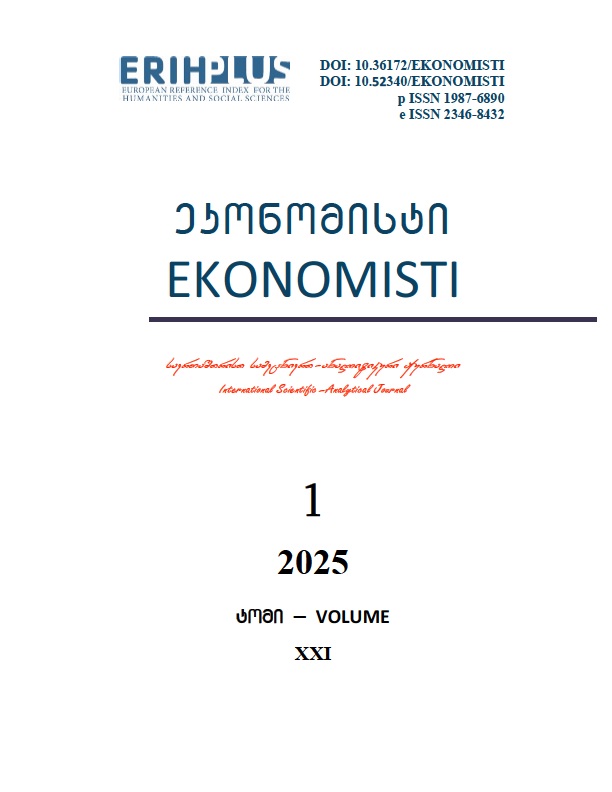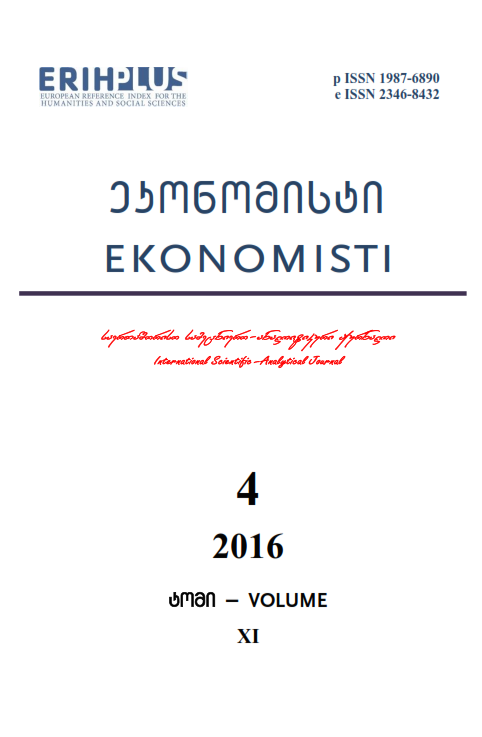
The international scientific and analytical, reviewed, printing and electronic journal of Paata Gugushvili Institute of Economics of Ivane Javakhishvili Tbilisi State University

The migration and potential of Georgian population from the period of gaining independence until today
Summary The article deals with the migration processes of Georgian population during 1992-2017. Based on the materials of the general population censuses of 2002 and 2014, it analyzes the dynamics and structure of the migrants. The article also presents characteristics of the migrants, according to the directions of migration and its primary causes. On the basis of the sociological research, it studies the motivation of the migration behavior of the Georgian students as the potential migrants in terms of employment and education. Key words: potential migration, education, employment, emigration, population census. Introduction Georgia is among one of those countries, where external migration played and still plays an important role in the formation of population and workforce. Consequently, the article aims to briefly present positive and negative factors currently affecting the migration of the Georgian population from the quantitative as well as qualitative standpoint. In this reMANAGEMENT OF ORGANIZATIONAL BEHAVIOR OF OVERNMENTAL AND MUNICIPAL EMPLOYEES AND THE WAYS OF PERFECTION
Expanded Summary Theoretical and methodological issues of organizational behavior has been developed on the given topic by such well known scientists as: M. Armstrong, G. Simon, D. Romans, P. Blau, D. Znanetski, R. Makiver, T. Harsons and others. In the structure of organizational behavior are separated personal, group and common organizational levels. As a result of study of social effect of groups’ behavior the researchers, who are working on the given problem have come to the conclusion, that the collective (group) methods of work organization and behavior have significant advantages and priority compared to the individuals. On the contemporary stage of public development particular importance is devoted to the processing of efficient methods and forms of management of the governmental and municipal employees work manners and behavior. In the&nWays of approximation and further compatibility of Georgian transport system with the European and International Standards
Summary Georgia has greatly deepened relations with the EU in recent years, which has been strengthened with the most powerful and comprehensive so-called EU-Georgia Association Agreement in the history of EU-Georgia relations. Since then the relationships between EU and Georgia have moved to a new, historically unprecedented level. The VI Title of the Association Agreement deals with transport and related issues and, first of all, envisages modernization of transport sphere and the introduction of European standards. The presented article discusses the ways of approximation and further interoperability of Georgian transport system with European and international standards and suggests specific proposals. The article is prepared on the basis of the Young Scientists Grant (N YS-2016-41) of Shota Rustaveli National Science Foundation. Keywords: transport, standard, infrastructure, regulations, recommendations Introduction Geographical location has always defined the role and poNonprofit Medical Organizations in Georgian Healthcare System
Expanded Summary There are several forms of ownership of medical organizations: Nonprofit, For-profit, State-owned, Public-private partnership. Such diversity is mostly due to the particularities of the medical market. However, there are predominantly two forms of ownership in Georgia – for-profit and state-owned. The most widespread form of ownership of health care organizations is the nonprofit one. In Europe, nonprofit hospitals make more than 70-80% of the hospitals. Similarly, in US, 57% of the hospitals are nonprofit, while 26% are state-owned (public) and private for-profit hospitals represent only 17%. Most of the physicians have private practice in profit and non-profit hospitals. Contrary to the above-mentioned, only two forms of ownership has developed in Georgia. But, we should not disregard one important fact: before sovietization of Georgia, charity hospitals existed in Georgia as well. For example, in Tbilisi, on the place where the former 9th hospital was situaProperty and entrepreneurship
Expanded Summary For almost three decades, Georgia has been in a difficult process of moving from one economic formation to another. Along with the social and political outcomes achieved in this transition period, the situation in the pure economic sense (human welfare) is so severe, which causes many reasons. Among them is one of the main causes of the decline of the economic development of the society (its economic structures) - the lack of private property and the lack of ownership in the use of incompatibility. Property, as an economic category, expresses the relationship between people and their behavior. But there is no property without entrepreneurship. If the property is not involved in the enterprise, property does not grow, it remains unchainged and usually decreases. From the day of creation privet property relationships was changed. Even those changes, which occurred during the development of capitalism, were so impressive and serious, that got a special term, in which tThe Estonian Model of Profit Tax – The Prospect of Economic Growth
Expanded Summary The most part of Georgia’s budget (approximately 92%) is made up of tax revenues, that is why it is very important to implement such legislative amendments, which, on the one hand, business and entrepreneurs will be tailored and on the other hand, to mobilize budget founds. Therefore, it is very important to consider the change, which refers to the replacement of the existing profit tax model with the Estonian model (since January 1, 2017). The above mentioned change is a challenge for the Georgian economy, because budget revenues are reduced by 400 million GEL per year in terms of profit tax. However, it is a great stimulus for entrepreneurs, because they have the opportunity of not levying tax of reinvestment profit, which is a guarantee of business expansion. Distributed profit tax in Estonia it has already been working for 18 years and it is regulated by The Income Tax Act, which entered into force in 2000. Distributed profit tax is subject to taxation:METHODICS OF THE CLUSTER CREATION OF SMALL INNOVATIVE ENTERPRISES IN GEORGIA
Expanded Summary In the beginning of the 21st century, almost all countries with advanced economies are interested in to promote regional innovation systems and clusters development policy, thus raise country’s national competitiveness as an opportunity of economic growth and development. Many examples of world practice demonstrate that the clustered form of the production is most favorable for the innovative process. Cluster helps the cooperation of interested bodies, forming the region’s unique competences, focusing enterprises and organizations in a specific area. The main task of modern Georgian economy is to activate innovative processes and to move it to innovative development. In this regard, special attention is paid to the tasks relating to innovation clusters as an independent event. Georgia should form a combination of favorable factors for innovative development. For supporting Clusters should be created a system of stateCost-effective primary healthcare and its benefits
Expanded Summary The complexity of medical services, especially outpatient services, is caused by the circumstances that provided services are not tangible. It is difficult to measure their characteristics, and of course, it requires high qualified, specific (medical) knowledge. Consumers find it difficult to evaluate the quality of healthcare services in advance since it is possible only after receiving them (in some cases it is even impossible). At the same time, the initial visit to a medical establishment does not mean that a patient is not looking for any other service provider, and this applies both to the medical establishment and the treating doctor. The patient’s satisfaction has a significant impact on continuing medical care. And the latter one, apart from cost-effective medical services, determines the adequate utilization of services. For the progress of the patient-oriented healthcare protection service it is important to improve both the accessibility of medical sMethodological Issues in Measuring Tourism Direct Economic Benefits
Expanded Summary Tourism is the most viable and sustainable economic development option for Georgia and one of the main sources of foreign exchange earnings. Number of international traveler visits is increasing in Georgia, contributing to the national economy. The given article stresses the necessity of research based economic policy in tourism sector. In this regard, it is of paramount importance to measure direct economic effects of the tourism. Public would like to know how much inbound visitors are contributing to the economy. In this article we discuss the methodology available around the world that helps answering this question. Tourism recognition as an economic development tool is increasing in lesser-developed nations, including Georgia. Tourism can promote economic development more quickly, than other industries, it can attract significant amount of financial capital, support infrastructural development and provide new job opportunities. Furthermore, if the couSTATE MARKETING AND ITS ROLE IN THE MANAGEMENT PROCESS
Expanded Summary The article deals with the importance of marketing in the state sector, the role of correctly developed state marketing programs on the condition of socio-economic challenges in the country. The use of state marketing programs and technologies will facilitate to solve the tasks set before the state, to overcome major problems, to ensure the development of private and civil society. The state marketing is an integral part of the management system that is integrated into socio-economic and political processes. Its main objective is to satisfy the needs of the public and private sectors. In the article are presented the marketing approaches and activities of central and local bodies studied by us. Within the framework of marketing research have been studied governmental marketing programs in the direction of using marketing instrumentalities and the country image enhancement. Here are some conclusions made based on the results of the survey. The use of marketingSome Issues in Improving the Organization of Labor Remuneration System in the Construction Sector of Georgia
Summary The paper deals with the opportunities of using one of the methods of strategic analysis and organization of effective remuneration system based on it to achieve financial sustainability in the construction sector of Georgia. Keywords: CVP Analysis, marginal income, break-even point, operational leverage, margin of safety. Introduction At every stage of economic activity, it is important for a businessman, when formulating a business strategy, to answer questions - how much profits are produced at a certain level of sales, also, about the minimum sales volume needed to ensure profitability, stability and growth of the company. CVP (Cost-Volume-Profit) analysis is one of the most effective methods of strategic analysis. Most auditors and experts use it to better assess the financial performance of the company and to provide well-substantiated recommendations (on organization development strategy). One of theEstimation of Government Spending Multiplier in Countries in Transition
Abstract This paper examines theoretical and empirical approaches for estimating government spending multiplier for Countries in Transition, among them the focus here is Post-Soviet Countries (CIS countries). Government spending multiplier is low in developing countries, mainly it is caused with high debt level and weak institutions of those economies, CIS countries are not exception of these features. The paper studies the effects of government spending on CIS economies and how this effect depends on economic conditions, such as public debt level, cyclical position of economy, currency regime and etc. Keywords: government spending multiplier, CIS economies Acknowledgment: I would like to show my warm thank to Professor Iuri Ananiashvili, who is my supervisor at the department of econometrics at Tbilisi State University. Also, I wish to present my special thanks to Professor Temirlan Moldogaziev and Professor James Monogan from University of Georgia (USA) for their
